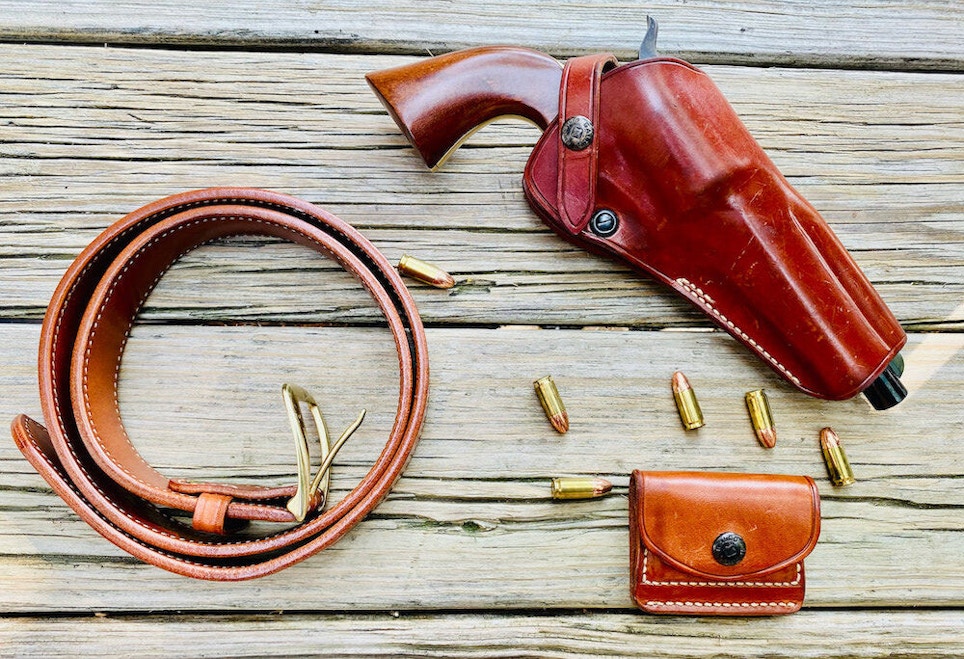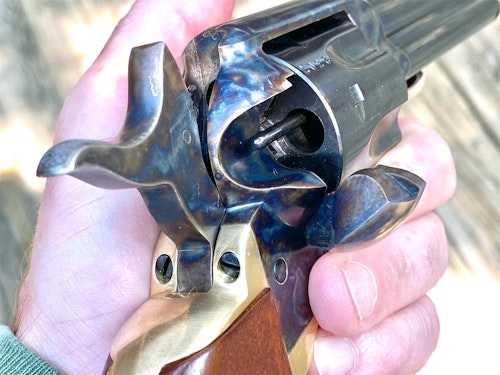Italian gun maker Uberti and Uberti-USA have scored one of the more surprising industry hits of 2022 and 2023 with three new models of single-action 1873 reproduction revolvers chambered in 9mm Luger.
Yes, 9mm Luger!
“Actually, we’ve had tons of requests the last few years for a single-action in 9mm,” says Tom Leoni, brand manager for Uberti-USA. “The three new 9mm SKUs have already been our biggest sellers of 2022 and we have a long list of 2023 backorders!”
The three new Uberti 9mm models are:
1873 El Patrón 9mm – Presented with checkered walnut grips, case-hardened frame, 5.5-inch blued barrel, numbered cylinder, and EasyView sights. Item Number 345372. MSRP $729.
1873 Cattleman Brass 9mm – The 1873 Cattleman Brass blends a sleek walnut grip, case-hardened frame, and blued steel barrel and cylinder with brass backstrap and trigger guard. Item Number #356211. MSRP $599.
1873 Cattleman Brass Dual Cylinder 9mm/.357 Magnum – Delivering the same performance and features as the 1873 Cattleman Brass 9mm, the 1873 Cattleman Brass Dual Cylinder ups the ante with two cylinders — one chambered in 9mm Luger and the other in .357 Magnum. Item Number 356212. MSRP $749.
According to Leoni, while the 9mm single actions have seen interest among historical gun buffs and collectors, the biggest customer base for these new revolvers has been among tactical and home defense customers.
“They already shoot Glocks, H&Ks, Sigs and other semi-autos, and they have a lot of 9mm ammunition on hand,” Leoni explains. “They are really interested in getting a different handgun or two to compliment the guns they already own. But they don’t want to mess around with another cartridge like the 45 Colt, traditionally the most common chambering for single-action models.
“With one of our new 9mm models, they can go to the range with two guns and just one caliber of ammunition. Easy!”
All well and good. But how does one of these 9mm 1873s actually function?
Pretty darned well, it turns out.
Home on the Range
I received a new-in-the-box 1873 Cattleman Brass 9mm and immediately noticed this is a real stunner of an 1873. The Cattleman Brass features a case-hardened finish on the receiver, a blued barrel and cylinder and a one-piece walnut grip, all of it set off by shiny brass trigger guard and backstrap.
In hand, the revolver’s 2 pounds and 3 ounces balanced nicely, and the handgun pointed naturally.
At my outdoor range, I began shooting the Cattleman Brass using Sig Sauer’s Elite Performance 9mm range ammunition firing a 124-grain full metal jacket bullet. I used a Champion 50 Foot Pistol Slow Fire target, with side-by-side bullseyes, and fired at the left bullseye at 5 yards, offhand.
That first cylinder produced a string of shots just to the left of the blue bullseye. Decent, but I was sure the Cattleman Brass could do better.
And it did. My second six shots punched one ragged hole that measured just .47 inches.
I backed up to 10 yards and still shooting offhand made three five-shot groups that averaged 1.5 inches.
While most shooters (including myself) wouldn’t consider an 1873 revolver a concealed carry option, the revolver certainly has home defense possibilities. So, I ran the Cattleman Brass with three different types of 9mm self-defense rounds: Terminal Shock from Dynamic Research Technologies, firing an 85-grain frangible bullet formed from powdered metals; Punch Personal Defense, from Federal Premium, loaded with a 124-grain jacketed hollow point; and Syntech Defense, also a Federal product, launching a 138-grain poly-coated bullet designed to break into three separate pieces plus the core upon penetration.
All three self-defense rounds pegged nice groups from 10 yards offhand. The Syntech Defense put five shots into the nogging Birchwood Casey Silhouette Bad Guy IPSC target that measured just 1.14 inches, and the Federal Punch produced a 1.46-inch group.
DRT wasn’t quite as accurate in the Cattleman Brass, though the 2.0-inch groups it consistently made were more than accurate enough to qualify as a very solid self-defense option.
Spent brass was easily ejected from the cylinder in standard 1873 fashion: I half-cocked the hammer, opened the loading gate on the right side of the cylinder and pushed back on the ejector rod located to the left side and just below the barrel. Out popped the empty brass. I turned the cylinder clockwise to the next chamber (with a very audible “click” when the cylinder was aligned on the new chamber) and repeated the ejector rod process.
Trigger pull on the Cattleman Brass averaged a crisp 1 pound, 6 ounces, according to my Lyman Digital Trigger Pull Gauge. If you’re dealing with customers who’ve only shot handguns with striker-fired triggers, let them dry fire the Cattleman Brass a couple times to see what a clean breaking trigger really feels like. Then, explain how this clean break translates into greater accuracy.
First-time customers for an 1873 revolver may have some issues with the traditional sights, though. Especially if they’ve used modern handguns with very visible sights, some may find the small rear notch cut into the top strap to be inadequate, though the rounded blade front sight certainly stands out.
It may take some practice to get used to these sights, which will cover up the target much more than their more modern counterparts. Yet, as the above-mentioned shooting groups can attest, these sights can more than do the job at standard handgun distances.
Modern Amenities
Uberti is well-known for its reproductions of classical, single-action revolvers, western heritage blackpowder revolvers and cartridge rifles, most of them “Old West” reproductions popular among those who do historical re-enactments, as well as single-action enthusiasts and competitors, plus those who simply appreciate the connection to America’s western expansion.
But, Uberti is firmly committed to the newest technologies and means of production, too, and has made a number of upgrades, if you will, to their Old West models, while still keeping the visual authenticity intact.
Unlike many other 1873 revolver reproductions featuring rimless cartridges, for example, the Cattleman Brass and the other Uberti 9mm models do not require the use of moon clips. Made in ring- or star-shaped models, moon clips hold the rounds together so they can be loaded and extracted at the same time. The flat side of the clip fits snug against the rear of the cylinder.
Moon clips function well, but they do require some extra work for loading and unloading and can be finicky.
Some potential customers of the Cattleman Brass may be aware of moon clips, so make sure to let them know that the 9mm rounds fit neatly into the cylinder without them, allowing cartridges to be loaded individually into the cylinder and ejected in the regular fashion.
Traditionally, the advice given when loading single-action 1873 revolvers was to only load five rounds into the cylinder and to then put the hammer down on the sixth and empty chamber. In this way, the revolver would not go off accidently if the revolver was dropped, for example, and the hammer hit the ground and drove the firing pin into the cartridge’s primer.
The Uberti Cattleman Brass and the other two 9mm models are built with a retractable firing pin, a breakthrough for those seeking enhanced safety with an 1873-style revolver. Uberti’s retractable firing pin design reduces the risk of accidental discharge because the firing pin is not locked into the firing position unless the trigger is pulled.
Of course, for ultimate safety, one can use the five-loaded and one-onloaded chamber method.
Uberti-USA is part of the Benelli-USA family of brands. Headquartered in Accokeek, Maryland, Benelli-USA encompasses the Benelli, Chapuis, Franchi and Stoeger brands in addition to Uberti. Dealers can pick and choose between the brands based on their customer base, and they need not carry a certain number of products or dollar amount of any one brand to be a dealer.
Uberti-USA firearms are sold strictly dealer direct, Leoni notes. “We have an extremely professional sales team, and we offer superior service and support to our retailers.”
Retailers need to buy into a minimal level to qualify for this sales support, though Leoni noted that level was only a few thousand dollars.
Retailers new to the 1873 market will want to consider also offering holsters and other leather accessories. No Old West revolver, after all, is complete without some classic leather. And the extra sales can be a big help to the bottom line.
This writer’s favorite carry rig is a triple-play from Galco GunLeather: a Strongside/Cross Draw Belt Holster; a 2X2X2X2 Ammo Carrier; and a sturdy SB2 Casual Holster Belt 1 ½”. The rig offered a comfortable and convenient way to carry the Cattleman Brass while at the range.
For more information about becoming an Uberti-USA dealer and the new 9mm 1873 models, contact the company at www.uberti-usa.com/contact-us.









